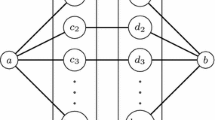Abstract
This paper studies the problem of finding a two-edge connected spanning subgraph of minimum weight. This problem is closely related to the widely studied traveling salesman problem and has applications to the design of reliable communication and transportation networks. We discuss the polytope associated with the solutions to this problem. We show that when the graph is series-parallel, the polytope is completely described by the trivial constraints and the so-called cut constraints. We also give some classes of facet defining inequalities of this polytope when the graph is general.
Similar content being viewed by others
References
F. Barahona, M. Grötschel, M. Junger and G. Reinelt, “An application of combinatorial optimization to statistical physics and circuit layout design,”Operations Research 36 (1988) 493–513.
F. Barahona and A.R. Mahjoub, “On two-connected subgraph polytopes,” Report RC 17845, IBM (New York, 1992).
N. Christofides, “The Traveling Salesman Problem,” in: N. Christofides, ed.,Combinatorial Optimization (Wiley, New York, 1979) pp. 131–150.
N. Christofides and C.A. Whitloch, “Network synthesis with connectivity constraints — A survey,” in: J.P. Brans, ed.,Operational Research No. 81 (North-Holland, Amsterdam, 1981) pp. 705–723.
G. Cornuéjols, J. Fonlupt and D. Naddef, “The traveling salesman problem on a graph and some related integer polyhedra,”Mathematical Programming 33 (1985) 1–27.
H. Crowder and M.W. Padberg, ” Solving large scale symmetric traveling salesman problem,”Management Sciences 26 (1980) 495–509.
W.H. Cunningham, “On bounds fo the metric TSP,” preprint (1989).
E.A. Dinits, “Algorithm for solution of a problem of maximum flow in a network with power estimation,”Soviet Mathematics Doklady 11 (1970) 1277–1280.
R.J. Duffin, “Topology of series—parallel networks,”Journal of Mathematical Analysis and Applications 10 (1965) 303–318.
J. Edmonds and R.M. Karp, “Theoretical improvement in algorithmic efficiency for network flow problems,”Journal of the Association for Computing Machinery 19 (1972) 248–264.
R.E. Erikson, C.L. Monma and A.F. Veinott, Jr., “Send-and-split method for minimum-concave-cost network flows,”Mathematics of Operations Research 12 (1987) 634–664.
J. Fonlupt and D. Naddef, “The traveling salesman problem in graphs with some excluded minors,”Mathematical Programming 53 (1992) 147–172.
L.R. Ford and D.R. Fulkerson, “Maximal flow through a network,”Canadian Journal of Mathematics 8 (1956) 399–404.
G.N. Frederickson and J. Ja'Ja', ”On the relationship between the biconnectivity augmentations and traveling salesman problem,”Theoretical Computer Sciences 13 (1982) 189–201.
M. Grötschel, L. Lovasz and A. Schrijver, “The ellipsoid method and its consequences in combinatorial optimization,”Combinatorica 1 (1981) 70–89.
M. Grötschel, M. Junger and G. Reinelt, “A cutting plane algorithm for the linear ordering problem,”Operations Research 32 (1984) 1195–1220.
M. Grötschel and C. Monma, “Integer polyhedra arising from certain network design problems with connectivity constraints,”SIAM Journal on Discrete Mathematics 3 (1990) 502–523.
M. Grötschel, C. Monma and M. Stoer, “Facets for polyhedra arising in the design of communication networks with low-connectivity constraints,” Report No. 187, Institut für Mathematik, Universität Augsburg (Augsburg, 1989).
M. Grötschel, C. Monma and M. Stoer, “Polyhedral approach to network survivability,” Report No. 189, Institut für Mathematik, Universität Augsburg (Augsburg, 1990).
E.L. Lawler, J.K. Lenstra, A.H.G. Rinnooy-Kan and D.B. Shmoys, “The Traveling Salesman Problem,” (Wiley, New York, 1985).
A.R. Mahjoub, “Two edge connected spanning subgraphs and polyhedra,” Report No. 88520-OR, Institut für Ökonometrie und Operations Research, Universität Bonn (Bonn, 1988).
C.L. Monma, B.S. Munson and W.R. Pulleyblank, ” Minimum-weight two connected spanning networks,”Mathematical Programming 46 (1990) 153–171.
R.G. Parker and R.L. Rardin, “The traveling salesman problem: an update of research,”Naval Research Logistics Quarterly 30 (1983) 69–96.
K. Steiglits, P. Weiner and D.J. Kleitman, “The design of minimum cost survivable networks,”IEEE Transactions and Circuit Theory 16 (1969) 455–460.
Author information
Authors and Affiliations
Additional information
Research supported in part by the Natural Sciences and Engineering Research Council of Canada and CP Rail and the German Research Association (Deutsche Forschungsgemeinschaft SFR 303).
Rights and permissions
About this article
Cite this article
Mahjoub, A.R. Two-edge connected spanning subgraphs and polyhedra. Mathematical Programming 64, 199–208 (1994). https://doi.org/10.1007/BF01582572
Received:
Revised:
Issue Date:
DOI: https://doi.org/10.1007/BF01582572




